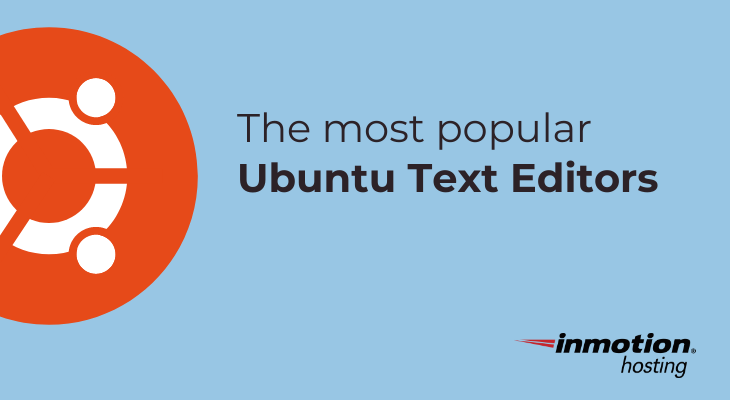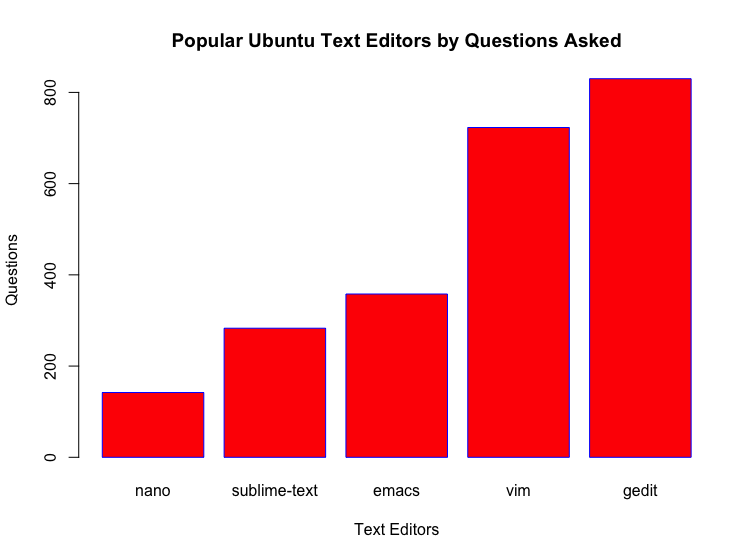
Having a favorite text editor can make one feel like a social misfit. But in the tech community, text editors are widely used and people hold highly opinionated views about which text editors are best. So arguments are welcome.
A popular text editor is sure to generate lively debate. I went on a search to find out the most popular text editor among Ubuntu users.
The best-kept secret is, no text editor is “the best” because it all depends on how you like to work. Your text editor, your life.
Why is this non-secret a secret? The secret is kept alive because the debate itself invigorates the power users of the world in their search for the perfect editor. What features really matter? What level of customization is necessary? Such questions make the search more enjoyable.
Most popular text editors:
For our analysis, we took a look at Ubuntu users to find out which editor was most popular. We found a mix of graphical user interface (GUI) and command line interface (CLI) editors.
The Results
The methodology was simple. I looked at all the questions in the Ask Ubuntu forum and sorted based on tags. Any question tagged with a certain editor was counted. As of June 2020, the popularity of these editors, based on tags, were as follows:

Upgrade to VPS Hosting for Peak Performance
Upgrade to InMotion VPS Hosting today for top-notch performance, security, and flexibility, and save up to $2,412 – a faster, stronger hosting solution is just a click away!
SSD Storage
High-Availability
Ironclad Security
Premium Support
Analysis of Each Editor
What makes a good text editor? The needs of each user will vary, but I’d say a good baseline criteria should be:
- Widely supported
- Active development
- User programmable
Over many years of usage, a good text editor should enliven one’s development practices. A static program, even and integrated development environment (IDE) bloated with lots of intuitive features, may makes some aspects of development easier.
But some users don’t want it to be easy. They want to feel the sense that they have adapted their editor to fit their needs rather than the other way around. The data on editor choice we discovered bears this out.
Likewise, if one’s own user programming is of great help, it might be of value to the community and should be shared.
Gedit
As mentioned in our methodology, the popularity of one editor over another is only based on questions asked.
So why did so many people ask questions about gedit?
- Is it because gedit comes pre-installed as the default text editor in Ubuntu?
- Is it because gedit is customizable?
- Is it because gedit has usability issues?
The questions are worth debating. If one were to look at the contents of the questions, you might generate multiple reasons for gedit’s popularity.
The point is, gedit meets most of the criteria we set for a good editor. It’s widely supported, easy to install to plugins, however it’s not highly user programmable unless the user is comfortable with C.
Gedit is designed for the gnome desktop environment and works well with it. If you’re looking for a fast, easy-to-use, and heavily expandable editor for Linux, gedit is a great choice. And it’s free and open source.
Vim
The classic, formidable, unflappable vim. For developers, sysadmins, and users of all kinds, vim, is the dependable workhorse. Many online tutorials assume some knowledge of vim, or they’ll give you the commands and you can just type them.
Vim is coded about 50% C and 50% “vim script,” so unless you’re comfortable with those languages, you may be limited to using plugins and custom scripts in terms of user programmability.
Most vim users will tell you it’s all about the keybindings. The vim keys for movement, editing, and manipulating text conform naturally to the movements and positions of your fingers on the keyboard.
This means that vim users, with much practice, can get really fast at completing complex text manipulations.
If speed is your thing, vim lets you rip faster through text than any other editor.
Vim keybindings are so popular, they’ve been ported into other text editors, as you’ll see when we take a look at emacs.
Emacs
Emacs, or “gnu emacs,” is the baroque text editor for all time. It’s a cross-platform, heavily customizable, master editor.
You’ve probably heard the old joke about how Emacs is an operating system with a decent text editor. That’s the kind of reputation that drives one to furiously type “LOL.”
But Emacs is no laughing matter. Beyond any mere text editor, emacs is an entire productivity system.
Coded mostly in Lisp, with some core components written in C—for compatibility purposes—emacs is highly programmable, with a wide community of users.
Emacs has earned a reputation for being difficult but worth the effort. With the advent of “Evil Mode,” the keybindings from Vim were ported into emacs, which meant any vim user could get the full emacs experience to satisfy their curiosity.
Emacs comes in both a command line and GUI variant, though the GUI is certainly more popular with a rich set of features.
There are also popular “flavors” of emacs, like the popular Spacemacs, which provide a higher-concept user interface and pre-loaded plugins. For users accustomed to vim, Spacemacs lets users choose at installation which keybindings they’d prefer to use. As the description for Spacemacs puts it: “The best editor is neither Emacs nor Vim, it’s Emacs and Vim!”
Sublime
Sublime Text, a “sophisicated” editor is certainly popular in the Ubuntu forums, but it’s wide compatibility with Linux, Mac, and Windows, makes it generally popular around the world.
Unlike vim or emacs, the Sublime editing window does not require much instruction to get going. You can open a new file, or open an old file, and start moving right away.
Sublime is also compatible with a wide array of plugins, including themes that can change the look and syntax highlighting within the window.
Available in free and paid versions, the Sublime editor free version will nag you to upgrade at regular intervals.
Nano
The nano editor is cute. Enough said?
Too many power users may look past nano without a second glance, but for many users it may provide the perfect balance of lightweight versatility with user programmability.
Nano, like vim and gedit, comes pre-installed with Ubuntu.
You can customize it with a configuration file. Some good options to configure are the syntax highlights for your favorite languages, or various text manipulations like auto-indent or wrapping. Nano can also save history and perform automatic backups.
All in all, for a tiny text editor, nano provides a nice feature set.
Did we leave out your favorite editor or feature?
When it comes to picking a favorite editor, the choices and options can seem endless. I started out using gedit, decided to move to vim, but then pivoted drastically toward emacs.
Your journey may be similiar. Often, you’ll find that one editor has a desirable feature not available in another. You may agonize over the tiniest details in deciding how important that one feature is to you. But the search has its own rewards.
No matter which editor you pick, eventually you’ll have to stop playing and do some work.
My choice is Codelobster editor.